Anomalous scaling of a passive scalar advected by the turbulent velocity field with finite
- 格式:pdf
- 大小:239.26 KB
- 文档页数:12
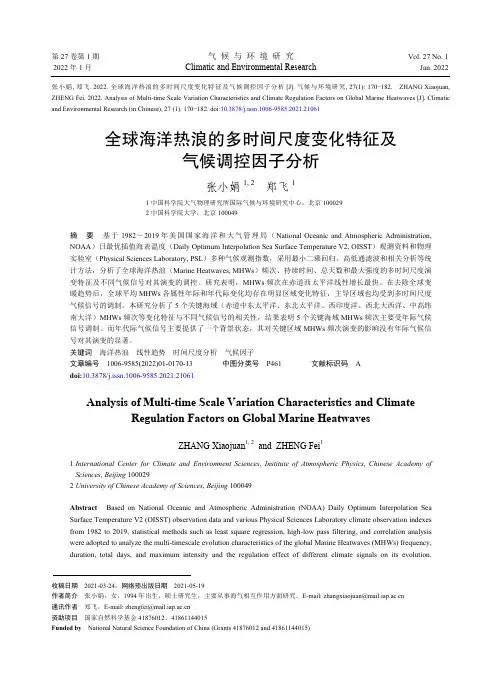
张小娟, 郑飞. 2022. 全球海洋热浪的多时间尺度变化特征及气候调控因子分析[J]. 气候与环境研究, 27(1): 170−182. ZHANG Xiaojuan,ZHENG Fei. 2022. Analysis of Multi-time Scale Variation Characteristics and Climate Regulation Factors on Global Marine Heatwaves [J]. Climatic and Environmental Research (in Chinese), 27 (1): 170−182. doi:10.3878/j.issn.1006-9585.2021.21061全球海洋热浪的多时间尺度变化特征及气候调控因子分析张小娟 1, 2 郑飞11 中国科学院大气物理研究所国际气候与环境研究中心,北京 1000292 中国科学院大学,北京 100049摘 要 基于1982~2019年美国国家海洋和大气管理局(National Oceanic and Atmospheric Administration,NOAA )日最优插值海表温度(Daily Optimum Interpolation Sea Surface Temperature V2, OISST )观测资料和物理实验室(Physical Sciences Laboratory, PSL )多种气候观测指数,采用最小二乘回归、高低通滤波和相关分析等统计方法,分析了全球海洋热浪(Marine Heatwaves, MHWs )频次、持续时间、总天数和最大强度的多时间尺度演变特征及不同气候信号对其演变的调控。
研究表明,MHWs 频次在赤道西太平洋线性增长最快。
在去除全球变暖趋势后,全球平均MHWs 各属性年际和年代际变化均存在明显区域变化特征,主导区域也均受到多时间尺度气候信号的调制。
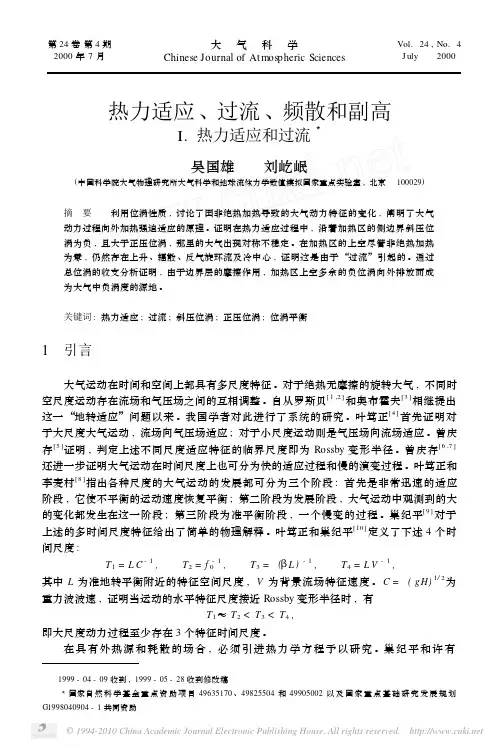
第24卷第4期2000年7月大 气 科 学Chinese Journal of Atmospheric SciencesVol.24,No.4J uly 2000热力适应、过流、频散和副高I.热力适应和过流3吴国雄 刘屹岷(中国科学院大气物理研究所大气科学和地球流体力学数值模拟国家重点实验室,北京 100029)摘 要 利用位涡性质,讨论了因非绝热加热导致的大气动力特征的变化,阐明了大气动力过程向外加热强迫适应的原理。
证明在热力适应过程中,沿着加热区的侧边界斜压位涡为负,且大于正压位涡,那里的大气出现对称不稳定。
在加热区的上空尽管非绝热加热为零,仍然存在上升、辐散、反气旋环流及冷中心,证明这是由于“过流”引起的。
通过总位涡的收支分析证明,由于边界层的摩擦作用,加热区上空多余的负位涡向外排放而成为大气中负涡度的源地。
关键词:热力适应;过流;斜压位涡;正压位涡;位涡平衡1 引言大气运动在时间和空间上都具有多尺度特征。
对于绝热无摩擦的旋转大气,不同时空尺度运动存在流场和气压场之间的互相调整。
自从罗斯贝[1,2]和奥布霍夫[3]相继提出这一“地转适应”问题以来。
我国学者对此进行了系统的研究。
叶笃正[4]首先证明对于大尺度大气运动,流场向气压场适应;对于小尺度运动则是气压场向流场适应。
曾庆存[5]证明,判定上述不同尺度适应特征的临界尺度即为Rossby变形半径。
曾庆存[6,7]还进一步证明大气运动在时间尺度上也可分为快的适应过程和慢的演变过程。
叶笃正和李麦村[8]指出各种尺度的大气运动的发展都可分为三个阶段:首先是非常迅速的适应阶段,它使不平衡的运动速度恢复平衡;第二阶段为发展阶段,大气运动中观测到的大的变化都发生在这一阶段;第三阶段为准平衡阶段,一个慢变的过程。
巢纪平[9]对于上述的多时间尺度特征给出了简单的物理解释。
叶笃正和巢纪平[10]定义了下述4个时间尺度:T1=L C-1, T2=f-10, T3=(βL)-1, T4=L V-1,其中L为准地转平衡附近的特征空间尺度,V为背景流场特征速度。
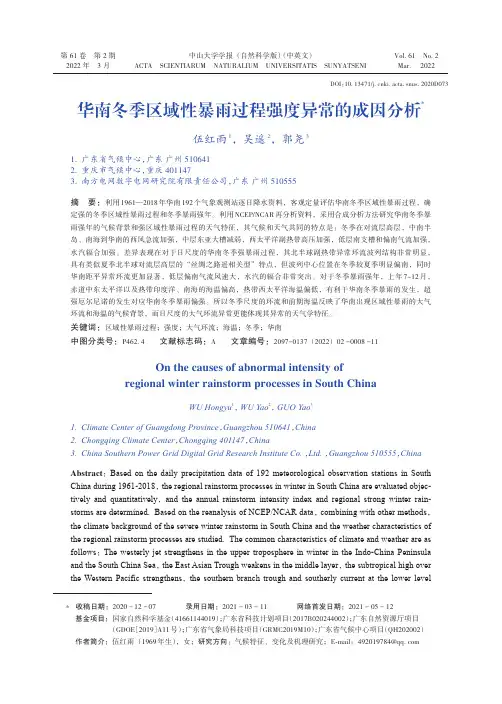
第61卷第2期2022年3月Vol.61No.2Mar.2022中山大学学报(自然科学版)(中英文)ACTA SCIENTIARUM NATURALIUM UNIVERSITATIS SUNYATSENI华南冬季区域性暴雨过程强度异常的成因分析*伍红雨1,吴遥2,郭尧31.广东省气候中心,广东广州5106412.重庆市气候中心,重庆4011473.南方电网数字电网研究院有限责任公司,广东广州510555摘要:利用1961—2018年华南192个气象观测站逐日降水资料,客观定量评估华南冬季区域性暴雨过程,确定强的冬季区域性暴雨过程和冬季暴雨强年。
利用NCEP/NCAR再分析资料,采用合成分析方法研究华南冬季暴雨强年的气候背景和强区域性暴雨过程的天气特征,其气候和天气共同的特点是:冬季在对流层高层,中南半岛、南海到华南的西风急流加强,中层东亚大槽减弱,西太平洋副热带高压加强,低层南支槽和偏南气流加强,水汽辐合加强。
差异表现在对于日尺度的华南冬季强暴雨过程,其北半球副热带异常环流波列结构非常明显,具有类似夏季北半球对流层高层的“丝绸之路遥相关型”特点,但波列中心位置在冬季较夏季明显偏南,同时华南距平异常环流更加显著,低层偏南气流风速大,水汽的辐合非常突出。
对于冬季暴雨强年,上年7~12月,赤道中东太平洋以及热带印度洋、南海的海温偏高,热带西太平洋海温偏低,有利于华南冬季暴雨的发生,超强厄尔尼诺的发生对应华南冬季暴雨偏强。
所以冬季尺度的环流和前期海温反映了华南出现区域性暴雨的大气环流和海温的气候背景,而日尺度的大气环流异常更能体现其异常的天气学特征。
关键词:区域性暴雨过程;强度;大气环流;海温;冬季;华南中图分类号:P462.4文献标志码:A文章编号:2097-0137(2022)02-0008-11On the causes of abnormal intensity ofregional winter rainstorm processes in South ChinaWU Hongyu1,WU Yao2,GUO Yao31.Climate Center of Guangdong Province,Guangzhou510641,China2.Chongqing Climate Center,Chongqing401147,China3.China Southern Power Grid Digital Grid Research Institute Co.,Ltd.,Guangzhou510555,China Abstract:Based on the daily precipitation data of192meteorological observation stations in South China during1961-2018,the regional rainstorm processes in winter in South China are evaluated objec‐tively and quantitatively,and the annual rainstorm intensity index and regional strong winter rain‐storms are determined.Based on the reanalysis of NCEP/NCAR data,combining with other methods,the climate background of the severe winter rainstorm in South China and the weather characteristics ofthe regional rainstorm processes are studied.The common characteristics of climate and weather are as follows:The westerly jet strengthens in the upper troposphere in winter in the Indo-China Peninsula and the South China Sea,the East Asian Trough weakens in the middle layer,the subtropical high overthe Western Pacific strengthens,the southern branch trough and southerly current at the lower levelDOI:10.13471/ki.acta.snus.2020D073*收稿日期:2020-12-07录用日期:2021-03-11网络首发日期:2021-05-12基金项目:国家自然科学基金(41661144019);广东省科技计划项目(2017B020244002);广东自然资源厅项目(GDOE[2019]A11号);广东省气象局科技项目(GRMC2019M10);广东省气候中心项目(QH202002)作者简介:伍红雨(1969年生),女;研究方向:气候特征、变化及机理研究;E-mail:492019784@第2期伍红雨,等:华南冬季区域性暴雨过程强度异常的成因分析strengthen,and the water vapor convergence strengthens.The difference is presented in the heavy rain process at the daily scale in South China in winter,in which the wave train structure of the northern hemisphere subtropical abnormal circulation is very obvious,similar to the‘remote correlation of silk road’in the upper troposphere of the northern hemisphere in summer circulation characteristics,but the center of oscillation is southerly in winter than it in summer.For the strong winter rainstorm year,the SST is higher in the equatorial Middle East Pacific,the tropical Indian Ocean,and the South China Sea,while it is lower in the tropical western Pacific from July to December in last year,which was conducive to the occurrence of winter rainstorm in South China.Therefore,the seasonal scale(particu‐larly in winter)circulation and early SST reflect the climate background of the regional rainstorm in South China,while the daily scale atmospheric circulation anomaly can better reflect its abnormal weather characteristics.Key words:regional rainstorm process;intensity;atmospheric circulation;SST;winter;South China随着全球气候变暖,南方冬季极端降水强度普遍增加[1],特别是2010年以来华南冬季区域性暴雨过程频繁发生,常常危害人民生命财产安全,甚至造成严重洪涝灾害。
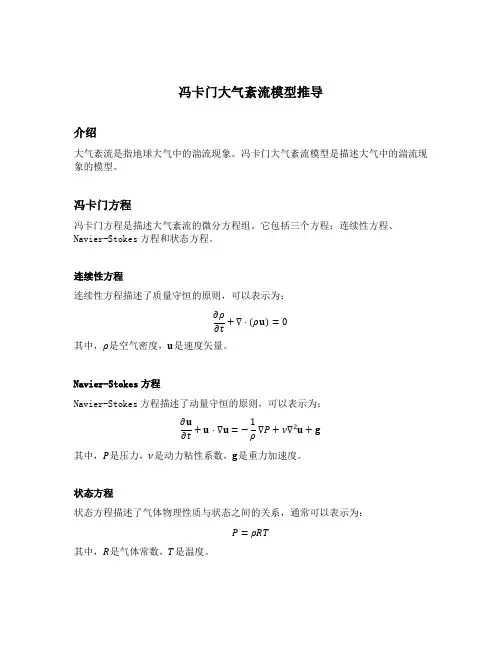
冯卡门大气紊流模型推导介绍大气紊流是指地球大气中的湍流现象。
冯卡门大气紊流模型是描述大气中的湍流现象的模型。
冯卡门方程冯卡门方程是描述大气紊流的微分方程组。
它包括三个方程:连续性方程、Navier-Stokes方程和状态方程。
连续性方程连续性方程描述了质量守恒的原则,可以表示为:∂ρ∂t+∇⋅(ρu)=0其中,ρ是空气密度,u是速度矢量。
Navier-Stokes方程Navier-Stokes方程描述了动量守恒的原则,可以表示为:∂u ∂t +u⋅∇u=−1ρ∇P+ν∇2u+g其中,P是压力,ν是动力粘性系数,g是重力加速度。
状态方程状态方程描述了气体物理性质与状态之间的关系,通常可以表示为:P=ρRT其中,R是气体常数,T是温度。
大气边界层大气边界层是指大气中靠近地表的一层区域,受到地表摩擦力和大气条件的影响。
在大气边界层中,湍流是主要的运动形式。
大气边界层可以分为三个不同的区域:大气表面层、颠簸层和波动层。
大气表面层大气表面层是距离地表几百米的一层区域。
在大气表面层中,湍流强度较大,主要受到地表摩擦力的影响。
这个区域的湍流可以通过冯卡门大气紊流模型来描述。
颠簸层颠簸层是距离地表几百米到几千米的一层区域。
在颠簸层中,湍流强度逐渐减弱,主要受到大气条件的影响。
波动层波动层是距离地表几千米以上的一层区域。
在波动层中,湍流强度较小,主要受到大气条件和地形等因素的影响。
大气紊流模拟方法大气紊流模拟是通过数值模拟方法来研究大气中的湍流现象。
目前常用的大气紊流模拟方法包括直接数值模拟(DNS)、大涡模拟(LES)和雷诺平均Navier-Stokes 方程模拟(RANS)等。
直接数值模拟(DNS)直接数值模拟是一种通过求解Navier-Stokes方程来模拟湍流的方法。
它可以精确地模拟湍流的细节,但需要消耗大量的计算资源。
大涡模拟(LES)大涡模拟是一种通过分解湍流流场为尺度较大的大涡和尺度较小的小涡来模拟湍流的方法。
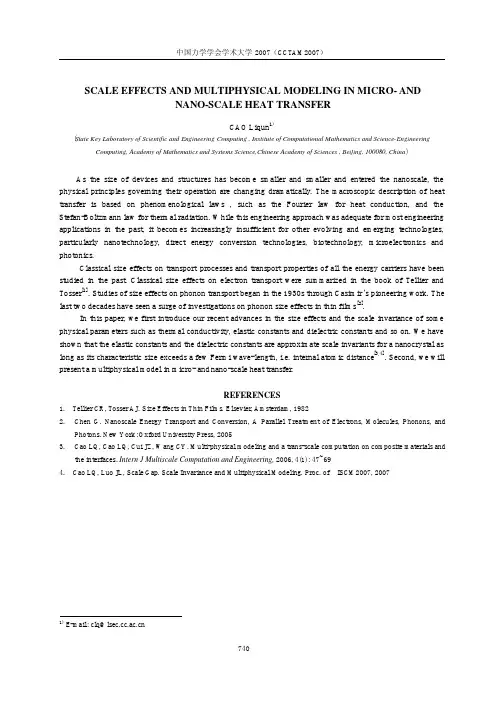
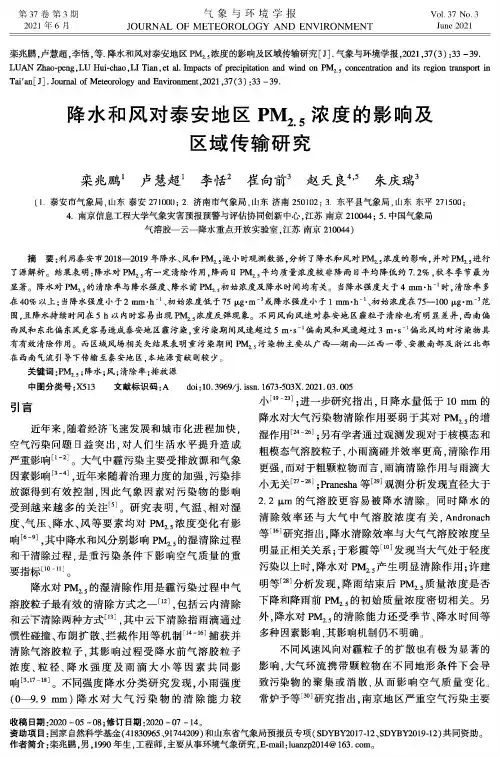


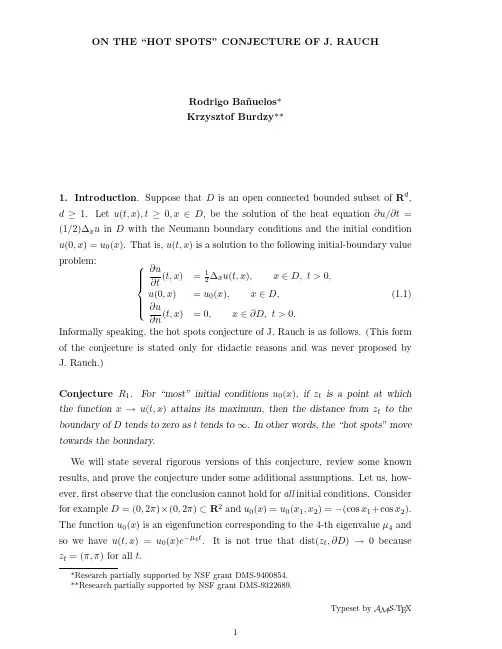
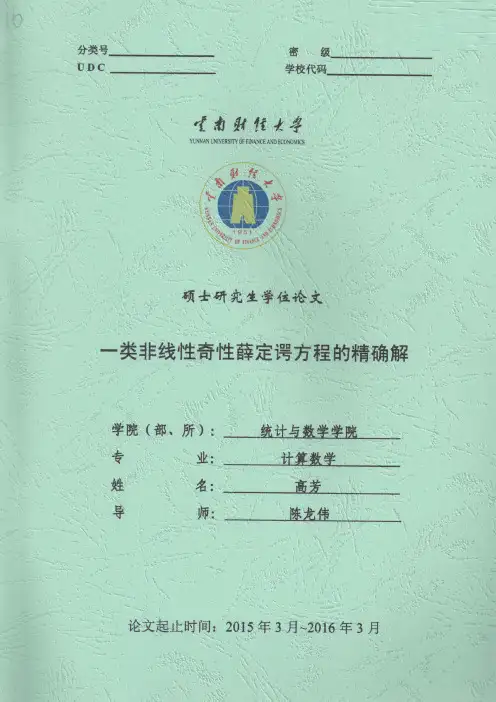
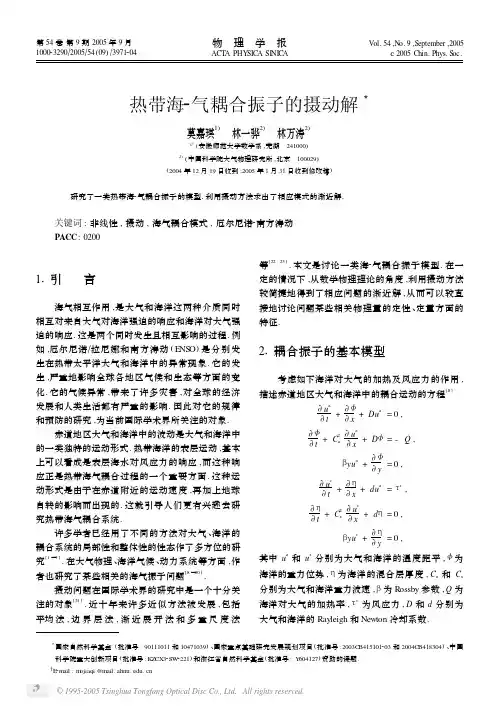
罪魁祸首——“北大西洋涛动”全球多个地区如今正受到严寒和暴雪影响,似乎有违全球暖化的逻辑。
但这其实只是天气轻微不稳时的必然现象,而且可以是自然发生的。
北美洲、欧洲和亚洲天气严寒,北大西洋被视为罪魁祸首。
一层罕见的冷水在海洋积聚,冷却空气,造成天气形势的发展受到阻碍,围绕格陵兰的大片区域成了高压区,朝向属亚热带气候的亚速尔群岛的区域则成了低压区。
就像一个向前后摇动的摇摇板那样,这两大套压力系统,可以由一个极端走向另一极端,在一种名为“北大西洋涛动”的现象中扰乱了冬天的天气。
随着北方的压力高得异常,涛动的指数目前属负数,造成大半个北半球冷得直打哆嗦。
北大西洋涛动的指数若属负数,亦会把急流(大气中的强风带)吹向更偏南处,把更温和及更潮湿的天气也带走,令北方的地区更寒冷。
即使是远离大西洋的中国及韩国等地也受到严寒侵扰。
英国气象局哈德利中心季节性预测组成员斯凯夫说:“近日,横跨欧亚大陆以至韩国地区都寒冷,这个反常现象和北大西洋涛动指数呈负数时的典型现象非常相似。
”北大西洋海域为什么如此寒冷,原因尚未清楚。
天气形势遭妨碍正常发展的情况在今年冬天会否或何时改变,也是未知之数。
不过,北欧的前景特别黯淡,原因在于太平洋的「厄尔尼诺」现象(南美洲对开热带海域不寻常变暖)日趋严重,预期令冬天进一步寒冷。
基本信息北大西洋涛动,英文名称:North Atlantic oscillation (NAO)北大西洋涛动于1920年由Sir Gilbert Walker(G.沃克)发现。
定义北大西洋涛动(NorthAtlanticOscillation)北大西洋地区海平面气压场上南北方向的持续反相振动。
主要与亚速尔高压和冰岛低压的年际变化相联系。
作为三大涛动之一,是由沃克在本世纪20年代首先提出的。
近代的研究不仅进一步证实了它的存在,而且揭示了它与大范围海洋和大气状况的联系。
有人用亚速尔群岛的蓬塔代尔加达斯和冰岛的阿库雷里之间的气压基,作为北大西洋涛动指数。
冯卡门大气紊流模型推导
冯卡门大气紊流模型是用来描述大气中运动物质的流动、扩散和
混合的一种数学模型。
该模型基于统计物理学中的随机过程理论,结
合了强度和尺度学说,用于模拟大气中大规模气流的统计性质。
该模型的推导过程可以简述如下:
1. 假设大气运动是一个随机过程。
即,对于任何一个时刻和位置,大气中的运动速度和方向都是随机的,无法精确预测。
2. 基于概率分布函数,可以描述这个随机过程的基本性质。
如运
动速度和方向的概率密度函数、相关函数等。
3. 进一步,可以利用基本的物理原理和数学工具来推导出这些概
率分布函数的表达式,以描述大气中有关的运动物质的统计性质。
例如,通过偏微分方程和统计物理学中的Langevin方程,可得到大气中
扩散性和相关性等统计特征。
4. 最后,将这些概率分布函数和统计特征代入到海拔高度、时间
和空间坐标的数学函数中,就可以建立起冯卡门大气紊流模型。
总的来说,冯卡门大气紊流模型是一个非常复杂的数学模型,需
要掌握多种数学和物理技术,同时也需要有对大气物理过程的深刻理
解和精确测量数据的支持。
它被广泛应用于气象、天气预报、空气质
量预测等领域。
doi:10.11676/qxxb2023.20230010气象学报高分辨率地形资料应用对CMA-MESO模式地面气象要素的影响*陈冬梅1 马玉龙1 李 源1 冯家莉1 高 彦1 尹鹏帅1 夏 昕2 万齐林1 Chen Dongmei1 Ma Yulong1 Li Yuan1 Feng Jiali1 Gao Yan1 Yin Pengshuai1 Xia Xin2 Wan Qilin11. 粤港澳大湾区气象监测预警预报中心,深圳,5180002. 深圳市国家气候观象台,深圳,5180001. Guangdong-Hongkong-Macau Greater Bay Area Weather Research Center for Monitoring Warning and Forecasting,Shenzhen 518000,China2. Shenzhen National Climate Observatory,Shenzhen 518000,China2023-02-10收稿,2023-07-06改回.陈冬梅,马玉龙,李源,冯家莉,高彦,尹鹏帅,夏昕,万齐林. 2023. 高分辨率地形资料应用对CMA-MESO模式地面气象要素的影响. 气象学报,81(6):897-910Chen Dongmei, Ma Yulong, Li Yuan, Feng Jiali, Gao Yan, Yin Pengshuai, Xia Xin, Wan Qilin. 2023. The impact of high-resolution topographic data on the CMA-MESO model prediction of ground meteorological elements. Acta Meteorologica Sinica, 81(6):897-910Abstract Orography influences atmospheric circulation on a variety of spatial and temporal scales. The representation of its impact in numerical weather prediction models remains a challenging issue since the orographic spectrum can only be partially resolved in models. As numerical atmospheric models develop towards running in sub-kilometer resolutions, the need for accurate depiction of orography details becomes increasingly important. In this study, a new method to process orography is implemented in the CMA-MESO model by incorporating a new high-resolution orographic database ASTER-1s and an improved orography filter. The new method can remove harmful noises and retain more detailed small-scall orography features in the model, which greatly improves the representation of orographic effects. This new orography processing method is evaluated in the CMA-MESO based on simulations in June and December 2020. Comparison with observations collected at more than 20000 sites indicates that using ASTER-1s data without changing the filter does not significantly improve the prediction of 2 m temperature and 10 m wind speed. Using ASTER-1s data together with a new filter can greatly improve the prediction, resulting in a reduction of mean root mean square errors by 6.4% and 4.9% for the monthly mean 2 m temperature and 10 m wind speed, respectively. The prediction of monthly mean precipitation is also improved but not as significantly as that for the temperature and wind speed. The energy spectrum analysis shows that the new orography processing method does not show unrealistic energy accumulation at high frequencies, indicating the reliability of this method. Results of the study indicate that the new orography processing method can significantly improve the accuracy of near-surface temperature and wind speed forecast and is numerically stable and reliable.Key words CMA-MESO, High-resolution orography, Filter, ASTER-1s摘 要 真实地形包含各自不同尺度的地形特征,对各种时空大气运动有深刻影响。
arXiv:nlin/0204044v1 [nlin.CD] 18 Apr 2002Anomalousscalingofapassivescalaradvectedbytheturbulentvelocityfieldwithfinitecorrelationtime:Two-loopapproximation
L.Ts.Adzhemyan1,N.V.Antonov1,andJ.Honkonen21DepartmentofTheoreticalPhysics,St.PetersburgUniversity,Ulyanovskaya1,St.Petersburg—Petrodvorez,198504,Russia
2TheoryDivision,DepartmentofPhysicalSciences,P.O.Box64,FIN-00014UniversityofHelsinki,Finland
(24December2001)
TherenormalizationgroupandoperatorproductexpansionareappliedtothemodelofapassivescalarquantityadvectedbytheGaussianself-similarvelocityfieldwithfinite,andnotsmall,corre-lationtime.Theinertial-rangeenergyspectrumofthevelocityischosenintheformE(k)∝k1−2ε,andthecorrelationtimeatthewavenumberkscalesask−2+η.Inertial-rangeanomalousscalingforthestructurefunctionsandothercorrelationfunctionsemergesasaconsequenceoftheexistenceinthemodelofcompositeoperatorswithnegativescalingdimensions,identifiedwithanomalousexponents.Forη>ε,theseexponentsarethesameasintherapid-changelimitofthemodel;forη(localturnoverexponent),theanomalousexponentsarenonuniversalthroughthedependenceonadimensionlessparameter,theratioofthevelocitycorrelationtimeandthescalarturnovertime.Theuniversalityrevealsitself,however,onlyinthesecondorderoftheεexpansion,andtheexponentsarederivedtoorderO(ε2),includinganisotropiccontributions.Itisshownthat,formoderaten,theorderofthestructurefunction,andd,thespacedimensionality,finitecorrelationtimeenhancestheintermittencyincomparisonwiththebothlimits:therapid-changeandquenchedones.Thesituationchangeswhennand/ordbecomelargeenough:thecorrectiontotherapid-changelimitduetothefinitecorrelationtimeispositive(thatis,theanomalousscalingissuppressed),itismaximalforthequenchedlimitandmonotonicallydecreasesasthecorrelationtimetendstozero.
PACSnumber(s):47.27.−i,47.10.+g,05.10.Cc
I.INTRODUCTIONInrecentyears,considerableprogresshasbeenachievedintheunderstandingofintermittencyandanomalousscalingoffluidturbulence.ThecrucialroleinthesestudieswasplayedbyasimplemodelofapassivescalarquantityadvectedbyarandomGaussianfield,whiteintimeandself-similarinspace,theso-calledKraichnan’srapid-changemodel[1].There,forthefirsttimetheexistenceofanomalousscalingwasestablishedonthebasisofamicroscopicmodel[2]andthecorrespondinganomalousexponentswerecalculatedwithincontrolledapproximations[3–6]andasystematicperturbationexpansioninaformalsmallparameter[7].DetailedreviewoftherecenttheoreticalresearchonthepassivescalarproblemandthebibliographycanbefoundinRef.[8].WithintheapproachdevelopedinRefs.[3–6],nontrivialanomalousexponentsarerelatedto“zeromodes,”thatis,homogeneoussolutionsoftheclosedexactdifferentialequationssatisfiedbytheequal-timecorrelationfunctions.Inthissense,therapid-changemodelappears“exactlysolvable.”Inawidercontext,zeromodescanbeinterpretedasstatisticalconservationlawsoftheparticledynamics[9].Theconceptofstatisticalconservationlawsappearsrathergeneral,beingalsoconfirmedinnumericalsimulationsbyRefs.[10,11],wherethepassiveadvectioninthetwo-dimensionalNavier–Stokesvelocityfield[10]andashellmodelofapassivescalar[11]werestudied.Thisobservationisratherintriguingbecauseinthosemodelsnoclosedequationsforequal-timequantitiescanbederivedduetothefactthattheadvectingvelocityhasafinitecorrelationtime(forapassivefieldadvectedbyavelocitywithgivenstatistics,closedequationscanbederivedonlyfordifferent-timecorrelationfunctions,andtheyinvolveinfinitediagrammaticseries).Onemaythusconcludethatbreakingtheartificialassumptionofthetimedecorrelationofthevelocityfieldisthecrucialpoint[10,11].Animportantissuerelatedtotheeffectsofthefinitecorrelationtimeistheuniversalityoftheanomalousexponents.Itwasarguedthattheexponentsmaydependonmoredetailsofthevelocitystatisticsthanonlytheexponentsηandε[12].ThisideawassupportedinRefs.[13,14],wherethecaseofshortbutfinitecorrelationtimewasconsideredforthespecialcaseofalocalturnoverexponent.Inthosestudies,theanomalousexponentswerederivedtofirstorderinsmallcorrelationtime,withKraichnan’srapid-changemodel[13]oranalogousshellmodelforascalarfield[14]takenaszerothorderapproximations.Theexponentsobtainedappearnonuniversalthroughthedependenceonthecorrelationtime.
1